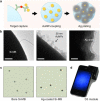Digital diffraction detection of protein markers for avian influenza
- PMID: 26980325
- PMCID: PMC4829473
- DOI: 10.1039/c5lc01558h
Digital diffraction detection of protein markers for avian influenza
Abstract
Rapid pathogen testing is expected to play a critical role in infection control and in limiting epidemics. Smartphones equipped with state-of-the-art computing and imaging technologies have emerged as new point-of-use (POU) sensing platforms. We herein report a new assay format for fast, sensitive and portable detection of avian influenza-associated antibodies.
Figures




Similar articles
-
A comparison of rapid point-of-care tests for the detection of avian influenza A(H7N9) virus, 2013.Euro Surveill. 2013 May 23;18(21):20487. Euro Surveill. 2013. PMID: 23725980 No abstract available.
-
Development of an influenza virus protein microarray to measure the humoral response to influenza virus infection in mallards.Emerg Microbes Infect. 2017 Dec 6;6(12):e110. doi: 10.1038/emi.2017.98. Emerg Microbes Infect. 2017. PMID: 29209053 Free PMC article.
-
Prototype single step lateral flow technology for detection of avian influenza virus and chicken antibody to avian influenza virus.J Immunoassay Immunochem. 2007;28(4):307-18. doi: 10.1080/15321810701603443. J Immunoassay Immunochem. 2007. PMID: 17885885
-
[Diagnostic tests: Avian influenza virus].Nihon Rinsho. 2005 Jul;63 Suppl 7:397-400. Nihon Rinsho. 2005. PMID: 16111284 Review. Japanese. No abstract available.
-
A Brief Introduction to Avian Influenza Virus.Methods Mol Biol. 2020;2123:83-92. doi: 10.1007/978-1-0716-0346-8_7. Methods Mol Biol. 2020. PMID: 32170682 Review.
Cited by
-
Point-of-care cervical cancer screening using deep learning-based microholography.Theranostics. 2019 Nov 26;9(26):8438-8447. doi: 10.7150/thno.37187. eCollection 2019. Theranostics. 2019. PMID: 31879529 Free PMC article.
-
Computational Optics for Point-of-Care Breast Cancer Profiling.Methods Mol Biol. 2022;2393:153-162. doi: 10.1007/978-1-0716-1803-5_8. Methods Mol Biol. 2022. PMID: 34837178 Free PMC article.
-
Computational Optics Enables Breast Cancer Profiling in Point-of-Care Settings.ACS Nano. 2018 Sep 25;12(9):9081-9090. doi: 10.1021/acsnano.8b03029. Epub 2018 Aug 20. ACS Nano. 2018. PMID: 30113824 Free PMC article.
-
Smartphone-based clinical diagnostics: towards democratization of evidence-based health care.J Intern Med. 2019 Jan;285(1):19-39. doi: 10.1111/joim.12820. Epub 2018 Sep 12. J Intern Med. 2019. PMID: 30079527 Free PMC article. Review.
References
Publication types
MeSH terms
Substances
Grants and funding
- UH2 CA202637/CA/NCI NIH HHS/United States
- R01-HL113156/HL/NHLBI NIH HHS/United States
- T32 CA079443/CA/NCI NIH HHS/United States
- 1K99CA201248-01/CA/NCI NIH HHS/United States
- HHSN268201000044C/HL/NHLBI NIH HHS/United States
- R01 EB010011/EB/NIBIB NIH HHS/United States
- R01 CA204019/CA/NCI NIH HHS/United States
- K12 CA087723/CA/NCI NIH HHS/United States
- R01-EB00462605A1/EB/NIBIB NIH HHS/United States
- R01 HL113156/HL/NHLBI NIH HHS/United States
- R01-EB010011/EB/NIBIB NIH HHS/United States
- K99 CA201248/CA/NCI NIH HHS/United States
- T32CA79443/CA/NCI NIH HHS/United States
- K12CA087723-11 A1/CA/NCI NIH HHS/United States
LinkOut - more resources
Full Text Sources
Other Literature Sources
Medical

